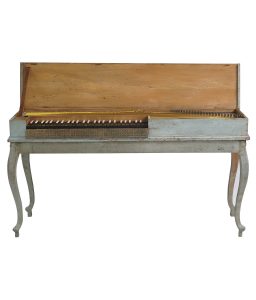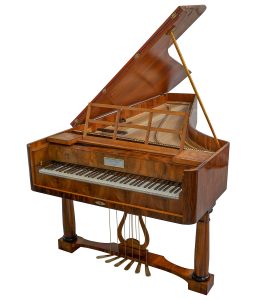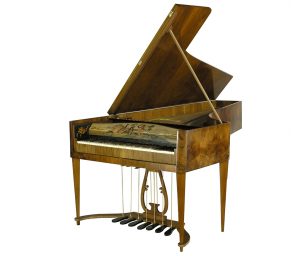RESTAURIERUNG
Die deutsche Version ist noch nicht verfügbar
We have been conserving/restoring historical keyboard instruments since 1996. During that period we have conserved/restored most types of keyboard stringed instruments, such as clavichords, spinets, harpsichords, fortepianos, pyramid pianos, table pianos, bureau pianos, etc. We conserved a large number of instruments for the National Museum (the Czech Museum of Music) for its exhibition „300 Years of the Piano“ held in 1999 under the auspices of UNESCO in 1999, and we have also conserved instruments comprehensively damaged in the disastrous floods of 2002, as well as other instruments of the Czech Museum of Music’s collection. We have also conserved instruments for the West Bohemian Monument Preservation Institute, the Academy of Performing Arts (HAMU), for several local muzeums and private individuals in the Czech Republic and abroad.
We have already conserved/restored more that 40 instruments.
In 2009 and 2010 we have been granted a licence for cultural heritage conservation, specialising in the conservation of keyboard string instruments from the Czech Ministry of Culture.
The filosophy of conservation
Every instrument is unique, has a different demage rate and requires individual approach and choice of technological processes. In case of conservation of historical instruments there is necessary to carefully consider the degree of intervention in an effort to preserve the instrument’s expressive value as much as possible while restoring its functionality and sound properties.
We carry out all conservation and restoration interventions in accordance with the conservator-restorer’s code of ethics.
Detailed photo documentation taken throughout the course of the work and a final conservation report are the obvious parts of conservation works.
During the restoration, we use both traditional original techniques and the most modern methods, mainly in the field of research – X-ray, 3D scan, microscopic stratigraphy and infrared spectrometry (FTIR) and we cooperate with a whole range of experts – conservators of textiles, paper, metal, paintings, etc.
We have been restoring historical keyboard instruments since 1996. During that period we have restored most types of keyboard stringed instruments, such as clavichords, spinets, harpsichords, fortepianos, pyramid pianos, table pianos, bureau pianos, etc. We restored a large number of instruments for the National Museum (the Czech Museum of Music) for its exhibition „300 Years of the Piano“ held in 1999 under the auspices of UNESCO in 1999, and we are also restoring instruments comprehensively damaged in the disastrous floods of 2002, as well as other instruments of the Czech Museum of Music’s collection.We have also restored instruments for the West Bohemian Monument Preservation Institute, the Academy of Performing Arts (HAMU) and for private individuals in the Czech Republic and abroad.
We have been restoring historical keyboard instruments since 1996. During that period we have restored most types of keyboard stringed instruments, such as clavichords, spinets, harpsichords, fortepianos, pyramid pianos, table pianos, bureau pianos, etc. We restored a large number of instruments for the National Museum (the Czech Museum of Music) for its exhibition „300 Years of the Piano“ held in 1999 under the auspices of UNESCO in 1999, and we are also restoring instruments comprehensively damaged in the disastrous floods of 2002, as well as other instruments of the Czech Museum of Music’s collection.We have also restored instruments for the West Bohemian Monument Preservation Institute, the Academy of Performing Arts (HAMU) and for private individuals in the Czech Republic and abroad.
List of the restored instruments:
- clavichords:
anonymous – Prague Conservatory
anonymous (mid-18th century) E 1581 – Czech Museum of Music
anonymous (mid-18th century) E 1582 – Czech Museum of Music
Amand Kunz (mid-18th century) E 701 – Czech Museum of Music - spinet:
anonymous – Prague Conservatory - harpsichord:
single-manual / anonymous with chinoiserie (post-1750) E 1352 – Czech Museum of Music - fortepianos:
Conrad Graf, Vienna (circa 1820) – Chateau Kozel
Joseph Dohnal, Vídeň (circa 1800) inv. no. 1381 St.5008, AMU – HAMU Prague
Jacob Hlauschek (Jakub Hloušek), Prague (between 1830 and 1846) E 1543 – Czech Museum of Music
Johann Balley (Jan Balley Nepomucký), Pilsner (between 1830-1840) E 2520 – Czech Museum of Music
Anton Ullrich, Prague (between 1820 and 1830) E 2587 – Czech Museum of Music
Joseph Dohnal, Vienna (between 1808 and 1818) E 2585 – Czech Museum of Music
Joseph Dohnal, Vienna (between 1808 and 1818) E 2838 – Czech Museum of Music
Steinweg C.F.Th., op.428, Brunschweig (between 1865 and 1869) E 2407 – Czech Museum of Music
Michael Weis op.761, Prague (between 1800 and 1807) E 2925 – Czech Museum of Music - pyramid piano:
anonymous, probably Vienna (between 1813 and 1820) E 1587 – Czech Museum of Music - table pianos:
anonymous (J.P.Krämer und Söhne, Göttingen 1808), E 1591 – Czech Museum of Music
anonymous, (between 1787 and 1815) – private collection - bureau piano:
Michael Weis, (between 1810 and 1820) E 1584 – Czech Museum of Music
More instruments coming soon



